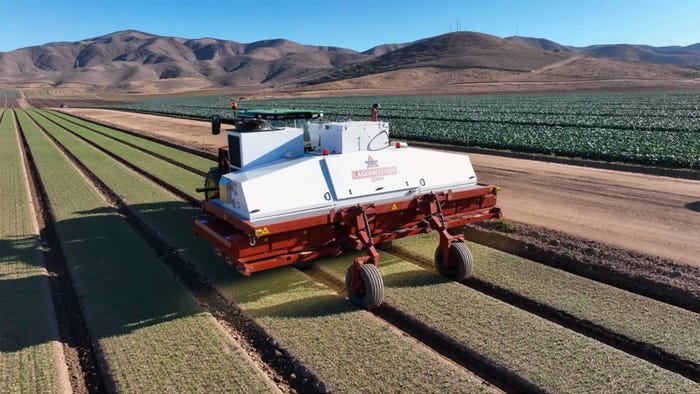
Weeds … you can douse them with herbicides or pull, smother, dig, disk, flame or plow them. Now, using artificial intelligence, computer vision and robotics, farmers can use lasers to pinpoint and explode weed cell walls and kill them.
As most can imagine, it’s not cheap nor is it for everyone, but large specialty and organic growers are putting it to use.
The LaserWeeder, a chemical-free, no-till, weed-control machine, is designed to eliminate more than 200,000 weeds per hour and offer up to 99% efficiency in weed death, according to its inventor, Carbon Robotics.
"Growers using LaserWeeders are seeing up to an 80% reduction in weed control costs and healthier crops with higher yields,” says Paul Mikesell, CEO of Seattle-based Carbon Robotics, who founded the company in 2018. “It also gives growers much greater control, predictability and data visibility."
A self-driven, prototype — used for demonstration only and not for sale — was a point of interest during the Midwest Mechanical Weed Control field day at Ohio State University's College of Food, Agricultural, and Environmental Sciences’ Wooster campus Sept. 27.
The for-sale, pull-behind implement uses 42 high-resolution cameras targeting weeds, with a dozen of them identifying and drawing a map of the weeds, Carbon Robotics sales representative Jeff Vander Voort says. That information is then processed by a computer that can identify 50 different crops and about 300 weed species.
How does it know the difference between a weed and a crop?
“We’ve got some of the smartest, artificial intelligence and machine-learning folks in the world working for us, and we can add new crop models in just a few days,” says Vander Voort, who covers the Great Lakes region and northeastern states.
He says the units are most prevalent in the West, especially in California’s large vegetable-growing regions, but the company has been expanding east during the past year, with an uptick in orders for the next year and a half.
“The goal is to eliminate weeds that steal moisture and nutrients from crops, while not disturbing the soil or spraying chemicals,” Vander Voort says.
Identifying weeds
As the machine inches along, bright lights under the unit flash across the ground, allowing it to work day or night, in all weather conditions.
The pull-behind implement is 20 feet wide and has 30 CO2 lasers and covers three 80-inch beds. “That unit sells for about $1.48 million for delivery in 2024,” Vander Voort says. They are also rolling out a slightly more expensive track unit.
“Oftentimes, we're seeing breakeven in the two- to three-year mark,” he says. “Some operations, if their weeding costs are really, really high, we’re seeing a breakeven in less than a year.”
That all depends on the particulars of each farm operation, including crops grown, costs and turns in a season.
“If you are relying heavily on chemicals or hand labor, those are single-use dollars and you only get the value for one season,” Vander Voort says. “When you make an investment into a LaserWeeder, you can return a lot of that money you’d be spending once every season back to yourself in the form of an asset. We see some pretty healthy cost savings on a per-acre basis.”
The company follows the sale with a robust implementation, he adds. “We make sure every operator on every farm we deliver a machine to is fully trained and knows how to operate to be successful with it,” Vander Voort says. “We are always within reach with 24-7 support coverage for our customers who are running day and night, all week long.”
The LaserWeeder was crowned 2023’s “Best AI-based Solution for Agriculture” for its time-saving efficiency — lowering costs of labor — in the sixth annual AI Breakthrough Awards program conducted by AI Breakthrough.
Technology is evolving rapidly, and it will continue to do so, Vander Voort points out. “It’s awesome to see a weed get shot with a laser,” he says.
About the Author(s)
You May Also Like






